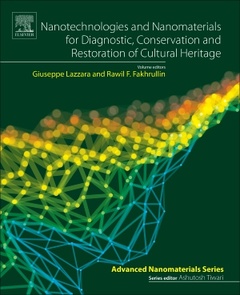Nanotechnologies and Nanomaterials for Diagnostic, Conservation and Restoration of Cultural Heritage Micro and Nano Technologies Series
Coordonnateurs : Lazzara Giuseppe, Fakhrullin Rawil F.

Nanotechnologies and Nanomaterials for Diagnostic, Conservation and Restoration of Cultural Heritage explores how advanced nanoscale techniques can help preserve artworks. The book covers lab-scale available techniques as well as advanced methods from neutron sources and X-ray spectroscopy. Other sections highlight a variety of nanomaterials with potential uses in treatments for restoration and conservation, with conservation, consolidation and long-term protection protocols analyzed in each case. The final chapter presents case studies, demonstrates how nanoscale techniques are used to conserve art, and shows what happens when misinterpretation of data sources leads to misdiagnosis.
The book is intended for scientists from academic and professional conservators, restorers who are involved in the conservation of artistic and historical artifacts, and those who want to learn how nanotechnology can increase the efficiency of conservation and protection techniques.
1. Advanced microscopy techniques for nanoscale diagnosis of Cultural Heritage 2. Neutron tomography 3. Synchrotron Radiation Imaging 4. Thermal analysis and analytical methods 5. Raman Spectroscopy and imaging 6. Multispectral and Fluorescence imaging 7. Nanoparticles for paper and wooden artefacts 8. Smart nanomaterials for cleaning 9. Parchments and canvas, from protein structure to artwork conservations 10. Enzymes and microorganisms for cleaning 11. Case studies from archaeological sites and museums 12. Conclusions, perspectives for Nanotechnologies and Nanomaterials in diagnosis, conservation and restoration of Cultural Heritage
Materials scientists working in the conservation sector and conservationists wanting to learn more about how nanotechnology can help create more effective preservation and restoration techniques
Rawil F. Fakhrullin received his MSc from Kazan State University in 2003, later receiving a PhD in Biochemistry form Kazan State University (2006), and DSc in Microbiology from Kazan Federal University (2011). He also received an MSc degree in Chemistry with Nanotechnology from University of Hull, UK. He worked as a visiting scientist at the University of Hull (UK), University of Sheffield (UK) and Yeditepe University (Istanbul, Turkey). Currently, hProfessor, Bionanotechnology Lab, Institute of Fundamental Medicine and Biology, Kazan Federal University, Kazan, Republic of Tatarstan, Russian Federation . His research interests are focused on development of novel biomimetic materials (including functionalised cells), cell-based therapy, drug delivery, controllable assembly of living cells into multicellular clusters, fabrication of cell-based biosensors, and nanotoxicity.
- Cogently explains how nanotechnology is used in the preservation, protection and restoration of artworks
- Explores the best nanomaterials for a variety of situations
- Shows how nanomaterials can be used in restoration, for cleaning and in conservation treatments
- Includes guidelines to prevent the misinterpretation of diagnostic data to help avoid misdiagnosis
Date de parution : 10-2018
Ouvrage de 432 p.
19x23.3 cm
Thèmes de Nanotechnologies and Nanomaterials for Diagnostic... :
Mots-clés :
Ablation; Acrylic paint; AFM; Ageing; Alkali-activated cements; Archaeology; Binders; Calcium silicate hydrate; Calorimetry; Cleaning treatment; Cleaning; Coating; Colloid; Consolidation treatment; Consolidation; Contemporary art; Correlative microscopy; Cultural heritage; Decontamination; Degradation; Dendrochronology; Dendroprovenancing; Dry cleaning methods; Drying oils; DSC; Enzymatic cleaning; Gel; Halloysite nanotubes; Hard materials; Herculaneum papyri; Illuminations; Iron-gall inks; Lime; Low-pressure plasma; Low-temperature plasma; Medieval manuscripts; Microemulsion; Modern art; Nanoclays; Nanocomposites; Nanofluid; Nanofluids; Nanomaterial; Nanotechnology; Neutron activation analysis; Neutron diffraction; Neutron imaging; Neutron resonance capture analysis; Neutron tomography; Neutrons; Nondestructive analysis; Nondestructive testing; Novel esterase; Optical microscopy; Painting; Paleoanthropology; Parchment; Pigments; Polycarboxylate ether superplasticizers; Portland cement; Pozzolanic mortars; Pozzolanic reaction; Prompt gamma activation analysis; Proteins



